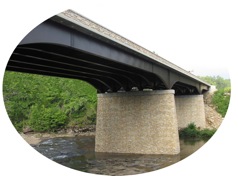Little River Canyon Bridge One of Top 50 U.S. Transportation Projects
12/11/2012

FORT PAYNE, Ala. – Strikingly beautiful, people-friendly and ecologically sustainable, the Little River Canyon Bridge on State Route 35 received national recognition from the Sierra Club as one of the 50 Best U.S. Transportation Projects in 2012 the Jacksonville State University Little River Canyon Center announced today.
“After partnering with the Alabama Department of Transportation to support its design and construction, we have used the bridge as a classroom for school classes, bird watchers, photographers, engineers and tourists from around the world, but now it’s even more, it’s a recognized model as how to build something right,” said JSU Little River Canyon Center Director Pete Conroy.
Transportation Director John Cooper agrees. “The Little River Canyon Bridge is an example of ALDOT’s commitment to work with local stakeholders to design a project that matches the landscape,” he said. “ALDOT worked with stakeholders to design a modern bridge that fits into one of Alabama’s most beautiful and scenic areas, and we worked hard to be environmentally responsible during construction. We’re committed to working in this manner on all ALDOT projects.”
Connecting Cherokee and DeKalb counties, the current bridge replaced the old State Route 35 Bridge built in 1948. Dedicated upon its completion in Sept. 15, 2010, the $7.6 million construction project combined functional and sustainable construction with aesthetics to enhance the natural beauty of the already breathtaking Little River Canyon National Preserve.
“The National Park Service is proud to have partnered with ALDOT in expanding a series of boardwalks under and all around the bridge. Visitors are treated to amazing views of Little River and the falls from the bridge,” said Gail Bishop, Superintendent of the Little River Canyon National Preserve.
The structural integrity and environmentally sensitive design of the bridge project is paving the way for similar projects in the future.
With a driving surface 53 feet above the riverbed, the bridge is 465 feet long and has only one pier set in the middle of the streambed, causing the least possible amount of impact to the natural flow of the river. Support beams and rebar were manufactured using recycled steel, and recycled asphalt was used to pave the driving surface. The bridge has a fully-developed pedestrian lane featuring three viewing areas with benches overlooking the scenic Little River Canyon and falls. Another unique aspect of the bridge is its 11,800 square feet of simulated stone masonry, adding overall artistic value and visual appeal. Additionally, materials from the old bridge were recycled and reused in other construction projects.

